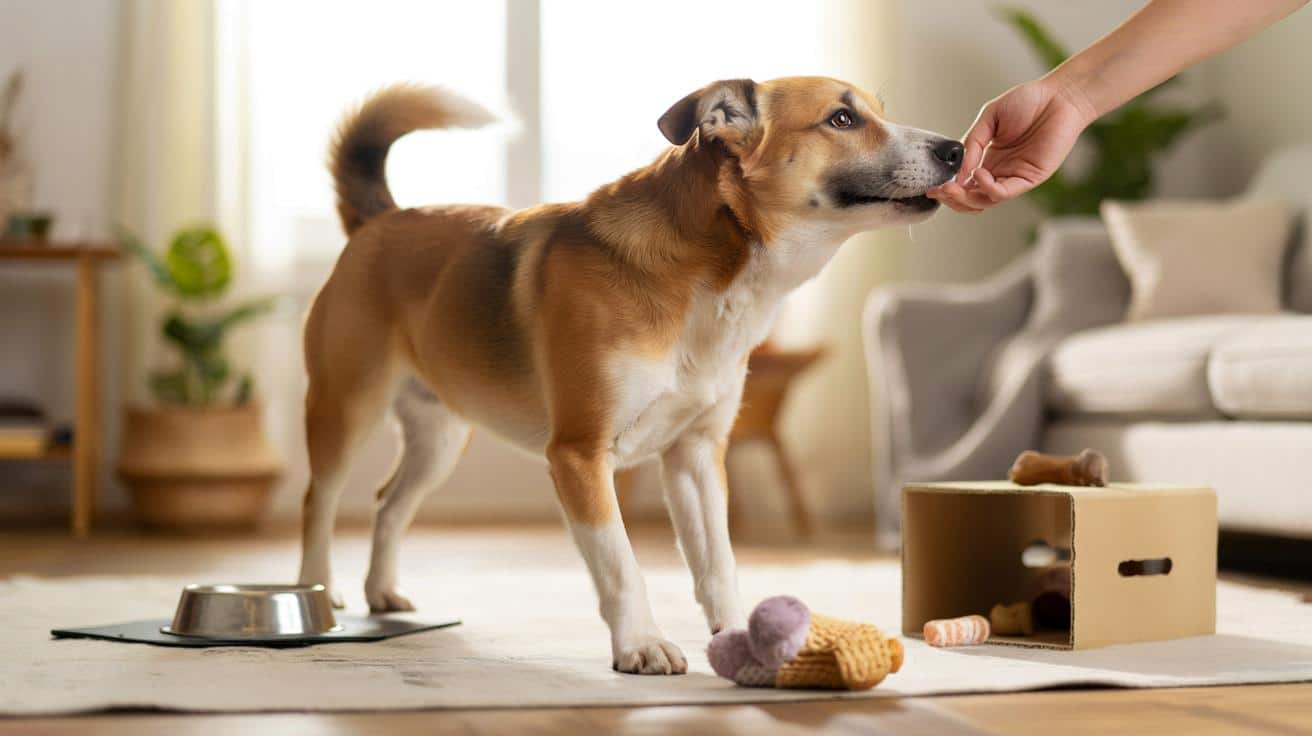Your pet’s body tells the story.
Veterinary behaviourists point to clear, repeatable signals that track mood and wellbeing. Some are obvious; others hide in daily routines and tiny shifts in posture, appetite and sleep.
Food as a mood barometer
Appetite ties closely to security and comfort. A steady, enthusiastic approach to meals signals confidence and calm. Dogs that eat at a predictable pace and finish most meals usually feel safe in their environment.
Sudden appetite loss, or overeating driven by anxiety, warrants a diary and a chat with your vet if it lasts beyond 48 hours.
Guarding the bowl, walking away mid-meal, or skipping food during family stress points to unease. Rule out dental pain, gut upset or medication effects before assuming fussiness. Keep mealtimes regular because reliable timing settles the nervous system and reduces cortisol spikes.
Sleep that signals safety
Adult dogs typically sleep 12–14 hours across a 24-hour period. Many pups reach 18 hours or more. Deep, twitchy sleep with relaxed limbs and soft breathing suggests a secure dog processing the day’s experiences.
Frequent night waking, pacing, or short, restless naps suggest anxiety, pain, or insufficient daytime activity.
Build a quiet sleep zone away from doorways and draughts. A consistent lights-out routine and a late-evening toilet break help prevent fragmented sleep. Older dogs may need extra cushioning for joints to preserve good rest.
Play as social currency
Play is not mere fun; it acts as social glue. Play bows, bouncy approaches, and the classic “bring the toy” invite mark trust and joy. Short, frequent sessions beat long, exhausting bursts and reduce frustration.
Vary formats to keep minds sharp. Tug teaches rules and impulse control. Scent games satisfy foragers. Short chase games suit sprinters, but swap to calm tasks before arousal peaks.
Curiosity and calm exploration
Happy dogs investigate their world. They sniff new scents, glance at novel sights, and recover quickly after being startled. Curiosity shows a flexible, confident brain rather than a hypervigilant one.
Rotate walk routes two or three times weekly. Scatter-feed in grass or use a simple cardboard “snuffle box” to create low-cost enrichment. Curiosity wanes with boredom and pain, so track changes.
Touch, proximity and trust
Affection looks different across dogs, yet it shares a theme: chosen contact. Many lie near your feet, lean gently into legs, or rest a chin on a knee. Mutual gaze boosts oxytocin in both species, and that chemistry calms heart rate.
Consent matters. Dogs that shift away, lick lips or turn the head ask for space. Respecting that signal strengthens trust, which in turn improves closeness over time.
What relaxed body language looks like
Comfort sits in the small details: a loose jaw, soft eyes, and a tail that sways like a metronome rather than whips like a propeller. Ears move freely and settle neutrally. Shoulders look fluid, not braced.
A soft, wiggly body with weight evenly spread and a gently wagging tail predicts a genuinely content dog.
Watch for tension lines, tucked tails, frozen stillness, or a hard stare. These show discomfort, not stubbornness. Film short clips on your phone at different times of day to build your own baseline for comparison.
Stable behaviour, low stress
Predictable routines reduce uncertainty. Dogs that cope when left alone for short periods, greet visitors without frenzy, and rest between activities show balanced arousal. Destructive chewing, incessant barking, or obsessive licking often flags distress.
Match exercise to breed and age, mixing physical work with brain work. Thirty minutes of sniff walks can tire a terrier more than a hard run on the lead. For many healthy adults, 60–90 minutes of varied activity across the day maintains steadiness.
At-a-glance signs you can track
| Sign | What it suggests |
|---|---|
| Finishes meals with steady interest | Confidence and routine comfort |
| 12–14 hours of restful sleep | Safety and adequate daytime outlets |
| Invites play with a bow or toy | Social trust and healthy arousal |
| Sniffs and explores new areas | Curiosity without fear |
| Loose, wiggly posture and soft eyes | Relaxation and contentment |
| Calm alone time up to 60–90 minutes | Low separation stress |
Three simple home tests vets recommend
The five-second consent check
Stroke your dog for five seconds, then stop. A happy, comfortable dog usually nudges, leans, or repositions closer for more. Turning away, lip licking, or yawning means pause and try later. This quick test reduces mixed messages and prevents grumbles.
The sniff-and-seek enrichment test
Hide five small treats in one room and release your dog to find them. Keen searching, tail sways, and problem-solving show a stimulated, upbeat mind. Skip this test if your dog guards food, and use toys instead. Repeat weekly to measure curiosity.
The recovery-from-greeting timing
After you return home, start a timer. Many well-adjusted dogs settle within three minutes once the initial greeting ends. Pacing, whining, or shadowing beyond ten minutes hints at separation distress. Practise low-key arrivals and departures to shorten recovery.
Your role in daily happiness
Consistency makes mood predictable. Feed and walk at similar times, and keep a simple weekly structure. Add short training bursts that pay well: recall games in the hall, two-minute scent finds, or targeting your hand to build focus. Short wins build confidence.
Use equipment that supports relaxation. A well-fitted Y-shaped harness protects shoulders. A two-metre lead allows sniffing without pulling. Swap metal bowls for rubber-footed ones to cut clatter if noise worries your dog.
Small, repeatable routines—meals on time, calm leads, brief brain games—often lift behaviour within two weeks.
When to seek professional help
Call your vet if appetite falls for more than two days, sleep changes suddenly, or play disappears. Pain hides behind “bad” behaviour. Sore ears, dental issues, and joint pain commonly fuel irritability and reactivity.
A registered clinical behaviourist can design a plan if separation issues, noise fears, or aggression appear. Early support shortens recovery and protects welfare.
Extra ways to stack the odds
- Temperature check: brachycephalic breeds overheat quickly; move play to cooler hours and offer water stations.
- Social dosing: schedule short, positive dog-dog contacts rather than busy parks if your dog prefers people.
- Foragers’ fix: trade one meal daily for sniff-based feeding to satisfy natural seeking systems.
- Pain audit: run a monthly head-to-tail feel for lumps, heat, flinches or stiffness, and note changes.
- Quiet quota: add two protected rest windows of 45–60 minutes with no visitors or deliveries.
A broader view: what happiness costs and saves
Enrichment does not have to be pricey. A cardboard box, a rolled towel, and ten kibble pieces create a puzzle that beats many shop toys. Ten minutes of scent work can halve nuisance barking that triggers neighbour complaints.
Balanced routines protect joints, weight, and mood. That payoff shows up in fewer vet visits for stress-linked tummy upsets, better recall on walks, and calmer evenings at home. Track three numbers each week—meals finished, hours slept, and recovery-from-greeting time—to keep an honest pulse on your dog’s happiness.








